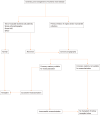Donor risk factors in pancreas transplantation
- PMID: 33437670
- PMCID: PMC7769731
- DOI: 10.5500/wjt.v10.i12.372
Donor risk factors in pancreas transplantation
Abstract
The aim of the work was to analyze and expose the donor and recipient risk factors in pancreas transplantation. In the following paper, we exposed the 2018 Spanish Consensus Document on Donor and Recipient Selection Criteria for Pancreas Transplantation. An assessment of the previous Selection Criteria for Donors and Recipients of Pancreas Transplantation, published in 2005 by the Spanish Pancreas Transplant Group (GETP) and the National Transplant Organization (ONT) was performed. A literature review was performed using Cochrane Library, PubMed and Google Scholar databases. Some of the following terms were used for the literature search: "Diabetes Mellitus," "Pancreas Transplantation," "Insulin-Secreting Cells," "Pancreas Allograft Thrombosis," "Allograft Pancreatitis," "Donors' Risk Factors," "Recipients' Risk Factors," "Pancreas Allograft Rejection" and "Pancreas Allograft Survival." After an extended search, different inclusion criteria were established. Articles and documents with abstracts of full text and in English or Spanish language were selected. Subsequently, different scientific meetings took place during 2015 and 2016 by the GETP. Finally, the updated criteria were published by the GETP and ONT in 2018. Several risk factors have been described in pancreas transplantation that can be divided into donor risk factors: Advanced age (> 50 years); high body mass index (BMI) (> 30 kg/m2); cause of death (e.g., stroke); previous hyperglycemia; hyperamylasemia; cold ischemia time (greater than 8 or 12 h, depending on the type of donation); the use of vasopressors in the intensive care unit or cardiac arrest; and the macroscopic aspect of the pancreas allograft. The following are recipient risk factors: Advanced age (> 50 years); active smoking; high BMI (> 30 kg/m2); and peripheral artery disease or sensorimotor polyneuropathy. Based on the aforementioned parameters, different selection criteria have been established for the recipients depending on the type of pancreas transplantation. Knowledge of the risk factors for pancreas transplantation allows the establishment of reliable selection criteria for choosing donors and recipients.
Keywords: Diabetes mellitus; Graft rejection; Pancreas donor; Pancreas recipient; Pancreas transplantation; Risk factors.
©The Author(s) 2020. Published by Baishideng Publishing Group Inc. All rights reserved.
Conflict of interest statement
Conflict-of-interest statement: The authors have no conflicts of interest to disclose.
Figures
Similar articles
-
Selected Mildly Obese Donors Can Be Used Safely in Simultaneous Pancreas and Kidney Transplantation.Transplantation. 2017 Jun;101(6):1159-1166. doi: 10.1097/TP.0000000000001303. Transplantation. 2017. PMID: 27428713
-
The UK DCD Risk Score: A new proposal to define futility in donation-after-circulatory-death liver transplantation.J Hepatol. 2018 Mar;68(3):456-464. doi: 10.1016/j.jhep.2017.10.034. Epub 2017 Nov 15. J Hepatol. 2018. PMID: 29155020
-
Tacrolimus in pancreas transplantation: a multicenter analysis. Tacrolimus Pancreas Transplant Study Group.Clin Transplant. 1997 Aug;11(4):299-312. Clin Transplant. 1997. PMID: 9267719 Clinical Trial.
-
Effect of donor hypertension on renal transplant recipients' blood pressure, allograft outcomes and survival: a systematic review and meta-analysis.Am J Cardiovasc Dis. 2019 Aug 15;9(4):49-58. eCollection 2019. Am J Cardiovasc Dis. 2019. PMID: 31516763 Free PMC article. Review.
-
Risk of extended criteria donors in hepatitis C virus-positive recipients.Liver Transpl. 2008 Oct;14 Suppl 2:S45-50. doi: 10.1002/lt.21617. Liver Transpl. 2008. PMID: 18825715 Review.
Cited by
-
Influence of Intraoperative Hemodynamic Parameters on Outcome in Simultaneous Pancreas-Kidney Transplant Recipients.J Clin Med. 2022 Apr 1;11(7):1966. doi: 10.3390/jcm11071966. J Clin Med. 2022. PMID: 35407575 Free PMC article.
-
Outcome-Orientated Organ Allocation-A Composite Risk Model for Pancreas Graft Evaluation and Acceptance.J Clin Med. 2024 Aug 31;13(17):5177. doi: 10.3390/jcm13175177. J Clin Med. 2024. PMID: 39274392 Free PMC article.
-
Pancreatic Differentiation of Oral Minor Salivary Gland Stem Cells.Stem Cell Rev Rep. 2024 Oct;20(7):1944-1953. doi: 10.1007/s12015-024-10757-9. Epub 2024 Jul 5. Stem Cell Rev Rep. 2024. PMID: 38967770
References
-
- Sutherland DE, Gruessner R, Gillingham K, Moudry-Munns K, Dunn D, Brayman K, Morel P, Najarian JS. A single institution's experience with solitary pancreas transplantation: a multivariate analysis of factors leading to improved outcome. Clin Transpl . :1991: 141–152. - PubMed
-
- Cicalese L, Giacomoni A, Rastellini C, Benedetti E. Pancreatic transplantation: a review. Int Surg. 1999;84:305–312. - PubMed
-
- Schulz T, Schenker P, Flecken M, Kapischke M. Donors with a maximum body weight of 50 kg for simultaneous pancreas-kidney transplantation. Transplant Proc. 2005;37:1268–1270. - PubMed
-
- Van der Werf WJ, Odorico J, D'Alessandro AM, Knechtle S, Becker Y, Collins B, Pirsch J, Hoffman R, Sollinger HW. Utilization of pediatric donors for pancreas transplantation. Transplant Proc. 1999;31:610–611. - PubMed
Publication types
LinkOut - more resources
Full Text Sources


